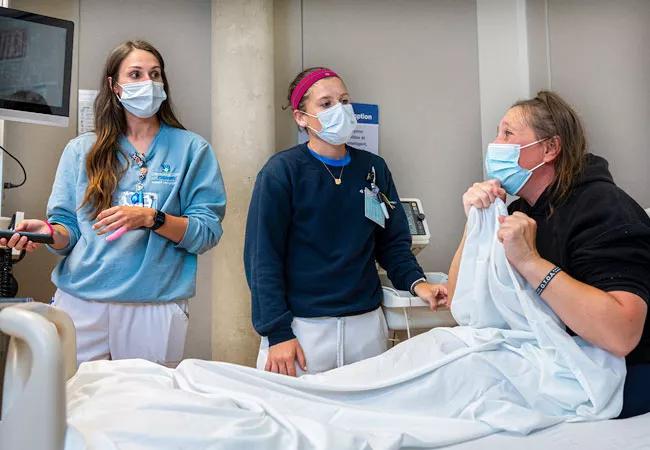Realistic scenarios stress importance of soft skills

In 2022, Cleveland Clinic added a new competency training scenario for pediatric nurses at three of its hospitals – main campus, Fairview Hospital and Hillcrest Hospital. The simulated experience focuses on patients with autism.
Cleveland Clinic is a non-profit academic medical center. Advertising on our site helps support our mission. We do not endorse non-Cleveland Clinic products or services. Policy
“With the prevalence of autism continuing to rise – now affecting one in 44 children —the likelihood of nurses coming into contact with a patient with the condition is very high,” explains Travis Haycook, MEd, assistant director of Cleveland Clinic Children’s Center for Autism. “If our nurses are more familiar with the possible behaviors that such patients might demonstrate during a medical experience and are educated on proven strategies for easing anxiety and behavioral exhibitions, the encounter is much more likely to be successful for everyone involved.”
The Cleveland Clinic Nursing Institute developed the training session, in part, based on feedback from pediatric nurses during an annual needs assessment. One of their top concerns was working with patients with autism.
Maureen Washock, BSN, RN, CPN, nursing professional development specialist, helped create the autism scenario with input from Haycook. During the session, nurses interact for five minutes with a standardized patient who portrays an individual with autism; afterward, they undergo a 15-minute debriefing with a nursing professional development specialist.
“Traditionally, we think of simulations using manikins, and our Standardized Patient Program is a division of the Simulation and Advanced Skills Center. But standardized patients offer something manikins can’t; they allow us to show neurodiversity,” says Washock. “We wanted to emphasize the soft skills required by nurses who work with this patient population.”
Washock sketched out a possible scenario, then teamed with Haycook to help ensure it accurately represented behavior typically demonstrated by a child with autism. In the scenario, nurses enter the room after being told by a nursing assistant that the patient became upset when they tried to take her blood pressure. The patient, who is rocking and repeating phrases, is verbally unresponsive to the nurse.
“The patient is clearly experiencing sensory overload, so we want the nurse to assess what’s bothering the child, remove excess stimuli and allow them time to calm down,” explains Washock.
During the debriefing session, the nurse and professional development specialist leading the training scenario discuss what went right and wrong, as well as strategies to help distract or redirect patients with autism. While each debriefing is tailored to the specific patient interaction, the following topics are often covered:
Approximately 275 nurses have participated in the autism competency training since its inception. Many of them have shared their appreciation with Washock, citing past patient experiences on nursing units where the training would have proven beneficial.
“I am not aware of any other program like this in the United States,” says Haycook. “It transcends the typical didactic learning format that most other programs offer and gives learners a valuable, practical experience to deepen their knowledge base. It provides them with an experience they can take with them into their real-life practice.”

Cleveland Clinic’s Executive CNO reflects on the image of nursing, aspirations for nurse leaders and more

Advice for preventing the negative physical and mental effects of sleep deprivation

Leadership rounds educate nurses and foster teamwork

Phone triage system reduces call backs and delays in care

Nurses play key role in comprehensive lifetime treatment program

Customized bots improve speed, efficiency by streamlining daily clinical, clerical tasks

Nurses play pivotal role in patients’ ability to recover in the comfort of their own homes

New protocol reduces costs, increases patient and caregiver satisfaction